IS 417 Business Intelligence Homework: Analytics and Allocation
VerifiedAdded on 2022/08/08
|10
|1663
|19
Homework Assignment
AI Summary
This homework assignment delves into key concepts within Business Intelligence, focusing on prescriptive analytics, its relationship with descriptive and predictive analytics, and the role of uncertainty in problem-solving. It explores how Linear Programming (LP) can be used to solve allocation problems, outlining the advantages and disadvantages of using LP packages. The assignment also covers the general process of simulation, highlighting its advantages and disadvantages compared to optimization. Furthermore, the assignment includes a practical problem involving a manufacturing scenario, requiring the determination of decision variables, the objective function, uncontrollable variables, and a feasible solution using linear programming constraints. The document provides a comprehensive understanding of these core topics in business intelligence.
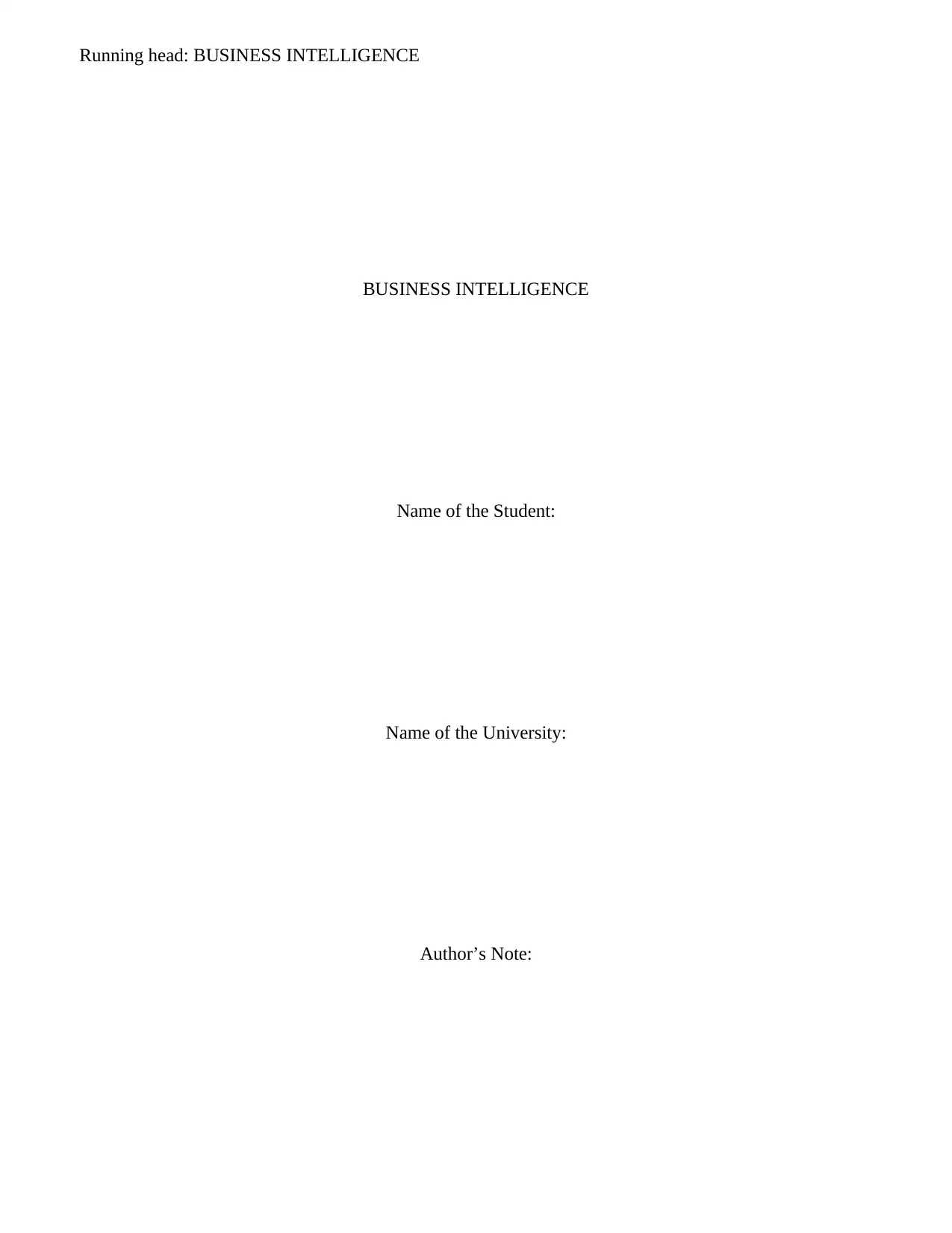
Running head: BUSINESS INTELLIGENCE
BUSINESS INTELLIGENCE
Name of the Student:
Name of the University:
Author’s Note:
BUSINESS INTELLIGENCE
Name of the Student:
Name of the University:
Author’s Note:
Paraphrase This Document
Need a fresh take? Get an instant paraphrase of this document with our AI Paraphraser
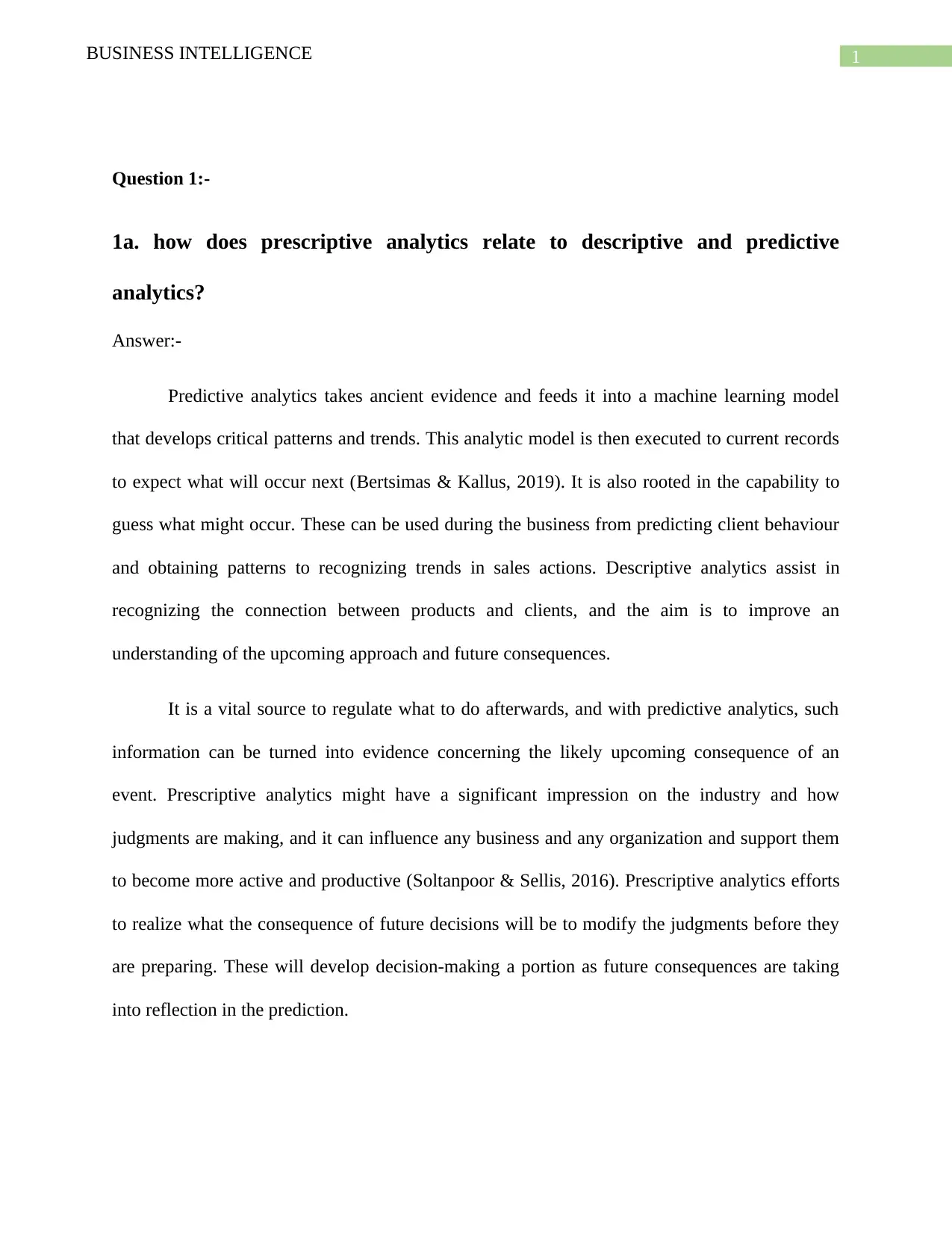
1BUSINESS INTELLIGENCE
Question 1:-
1a. how does prescriptive analytics relate to descriptive and predictive
analytics?
Answer:-
Predictive analytics takes ancient evidence and feeds it into a machine learning model
that develops critical patterns and trends. This analytic model is then executed to current records
to expect what will occur next (Bertsimas & Kallus, 2019). It is also rooted in the capability to
guess what might occur. These can be used during the business from predicting client behaviour
and obtaining patterns to recognizing trends in sales actions. Descriptive analytics assist in
recognizing the connection between products and clients, and the aim is to improve an
understanding of the upcoming approach and future consequences.
It is a vital source to regulate what to do afterwards, and with predictive analytics, such
information can be turned into evidence concerning the likely upcoming consequence of an
event. Prescriptive analytics might have a significant impression on the industry and how
judgments are making, and it can influence any business and any organization and support them
to become more active and productive (Soltanpoor & Sellis, 2016). Prescriptive analytics efforts
to realize what the consequence of future decisions will be to modify the judgments before they
are preparing. These will develop decision-making a portion as future consequences are taking
into reflection in the prediction.
Question 1:-
1a. how does prescriptive analytics relate to descriptive and predictive
analytics?
Answer:-
Predictive analytics takes ancient evidence and feeds it into a machine learning model
that develops critical patterns and trends. This analytic model is then executed to current records
to expect what will occur next (Bertsimas & Kallus, 2019). It is also rooted in the capability to
guess what might occur. These can be used during the business from predicting client behaviour
and obtaining patterns to recognizing trends in sales actions. Descriptive analytics assist in
recognizing the connection between products and clients, and the aim is to improve an
understanding of the upcoming approach and future consequences.
It is a vital source to regulate what to do afterwards, and with predictive analytics, such
information can be turned into evidence concerning the likely upcoming consequence of an
event. Prescriptive analytics might have a significant impression on the industry and how
judgments are making, and it can influence any business and any organization and support them
to become more active and productive (Soltanpoor & Sellis, 2016). Prescriptive analytics efforts
to realize what the consequence of future decisions will be to modify the judgments before they
are preparing. These will develop decision-making a portion as future consequences are taking
into reflection in the prediction.

2BUSINESS INTELLIGENCE
1b. Explain why solving problems under uncertainty sometimes involves
assuming that the problem is to be solved under conditions of risk.
Answer:-
Modelling tactics that could assist adaptive management approaches to look to be named
for, not only as uncertainty denotes improved economic indecision but also because innovative
and more dependable evidence becomes accessible as time passes. One decision-maker is
conscious of several probable states of nature but has inadequate evidence to assign any
possibilities of occurrence to them, is named as decision-making under uncertainty.
Judgment under uncertainty is when there are several nonentities and no opportunity of
expressing what could happen in the forthcoming to alter the consequence of a resolution
(Grossmann et al., 2016). The problem references to any category of circumstances might be of
numerous reason along with the detail that was dealing as well as solving the similar might have
the condition of differently standing methodologies.
Each business administrators are making problem‐solving decisions under some several
situations like as uncertainty, risk and certainty. All administrators make judgments under every
condition, but hazard and indecision are familiar to the more unstructured and complex problems
faced by top business directors (Kochenderfer, 2015). Decision making under situations of
uncertainty is like presence a creator entering unfamiliar territory. Uncertainty forces executives
to rely significantly on creativity in solving problems: It needs unique and frequently totally
innovative replacements to existing procedures.
1b. Explain why solving problems under uncertainty sometimes involves
assuming that the problem is to be solved under conditions of risk.
Answer:-
Modelling tactics that could assist adaptive management approaches to look to be named
for, not only as uncertainty denotes improved economic indecision but also because innovative
and more dependable evidence becomes accessible as time passes. One decision-maker is
conscious of several probable states of nature but has inadequate evidence to assign any
possibilities of occurrence to them, is named as decision-making under uncertainty.
Judgment under uncertainty is when there are several nonentities and no opportunity of
expressing what could happen in the forthcoming to alter the consequence of a resolution
(Grossmann et al., 2016). The problem references to any category of circumstances might be of
numerous reason along with the detail that was dealing as well as solving the similar might have
the condition of differently standing methodologies.
Each business administrators are making problem‐solving decisions under some several
situations like as uncertainty, risk and certainty. All administrators make judgments under every
condition, but hazard and indecision are familiar to the more unstructured and complex problems
faced by top business directors (Kochenderfer, 2015). Decision making under situations of
uncertainty is like presence a creator entering unfamiliar territory. Uncertainty forces executives
to rely significantly on creativity in solving problems: It needs unique and frequently totally
innovative replacements to existing procedures.
⊘ This is a preview!⊘
Do you want full access?
Subscribe today to unlock all pages.

Trusted by 1+ million students worldwide
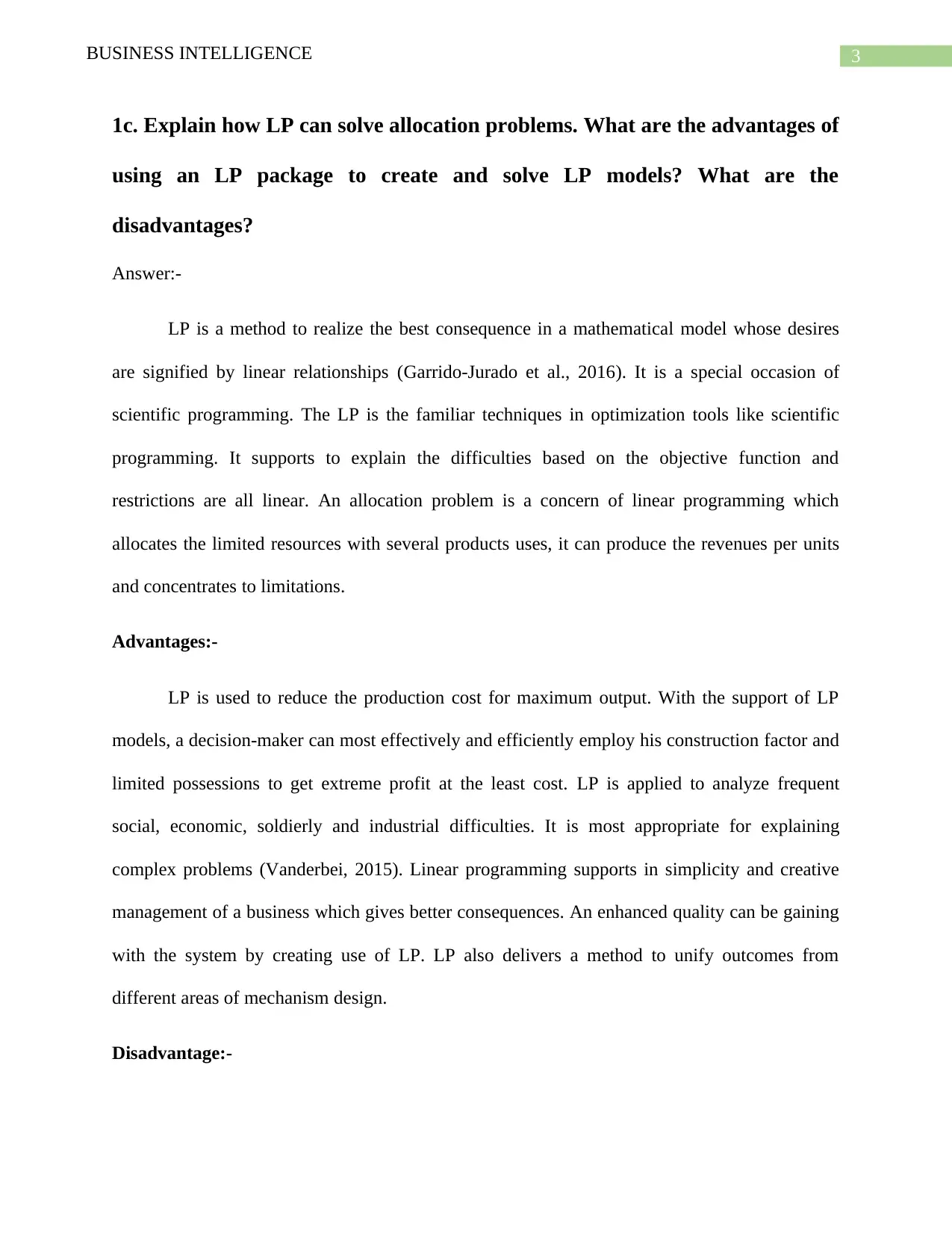
3BUSINESS INTELLIGENCE
1c. Explain how LP can solve allocation problems. What are the advantages of
using an LP package to create and solve LP models? What are the
disadvantages?
Answer:-
LP is a method to realize the best consequence in a mathematical model whose desires
are signified by linear relationships (Garrido-Jurado et al., 2016). It is a special occasion of
scientific programming. The LP is the familiar techniques in optimization tools like scientific
programming. It supports to explain the difficulties based on the objective function and
restrictions are all linear. An allocation problem is a concern of linear programming which
allocates the limited resources with several products uses, it can produce the revenues per units
and concentrates to limitations.
Advantages:-
LP is used to reduce the production cost for maximum output. With the support of LP
models, a decision-maker can most effectively and efficiently employ his construction factor and
limited possessions to get extreme profit at the least cost. LP is applied to analyze frequent
social, economic, soldierly and industrial difficulties. It is most appropriate for explaining
complex problems (Vanderbei, 2015). Linear programming supports in simplicity and creative
management of a business which gives better consequences. An enhanced quality can be gaining
with the system by creating use of LP. LP also delivers a method to unify outcomes from
different areas of mechanism design.
Disadvantage:-
1c. Explain how LP can solve allocation problems. What are the advantages of
using an LP package to create and solve LP models? What are the
disadvantages?
Answer:-
LP is a method to realize the best consequence in a mathematical model whose desires
are signified by linear relationships (Garrido-Jurado et al., 2016). It is a special occasion of
scientific programming. The LP is the familiar techniques in optimization tools like scientific
programming. It supports to explain the difficulties based on the objective function and
restrictions are all linear. An allocation problem is a concern of linear programming which
allocates the limited resources with several products uses, it can produce the revenues per units
and concentrates to limitations.
Advantages:-
LP is used to reduce the production cost for maximum output. With the support of LP
models, a decision-maker can most effectively and efficiently employ his construction factor and
limited possessions to get extreme profit at the least cost. LP is applied to analyze frequent
social, economic, soldierly and industrial difficulties. It is most appropriate for explaining
complex problems (Vanderbei, 2015). Linear programming supports in simplicity and creative
management of a business which gives better consequences. An enhanced quality can be gaining
with the system by creating use of LP. LP also delivers a method to unify outcomes from
different areas of mechanism design.
Disadvantage:-
Paraphrase This Document
Need a fresh take? Get an instant paraphrase of this document with our AI Paraphraser
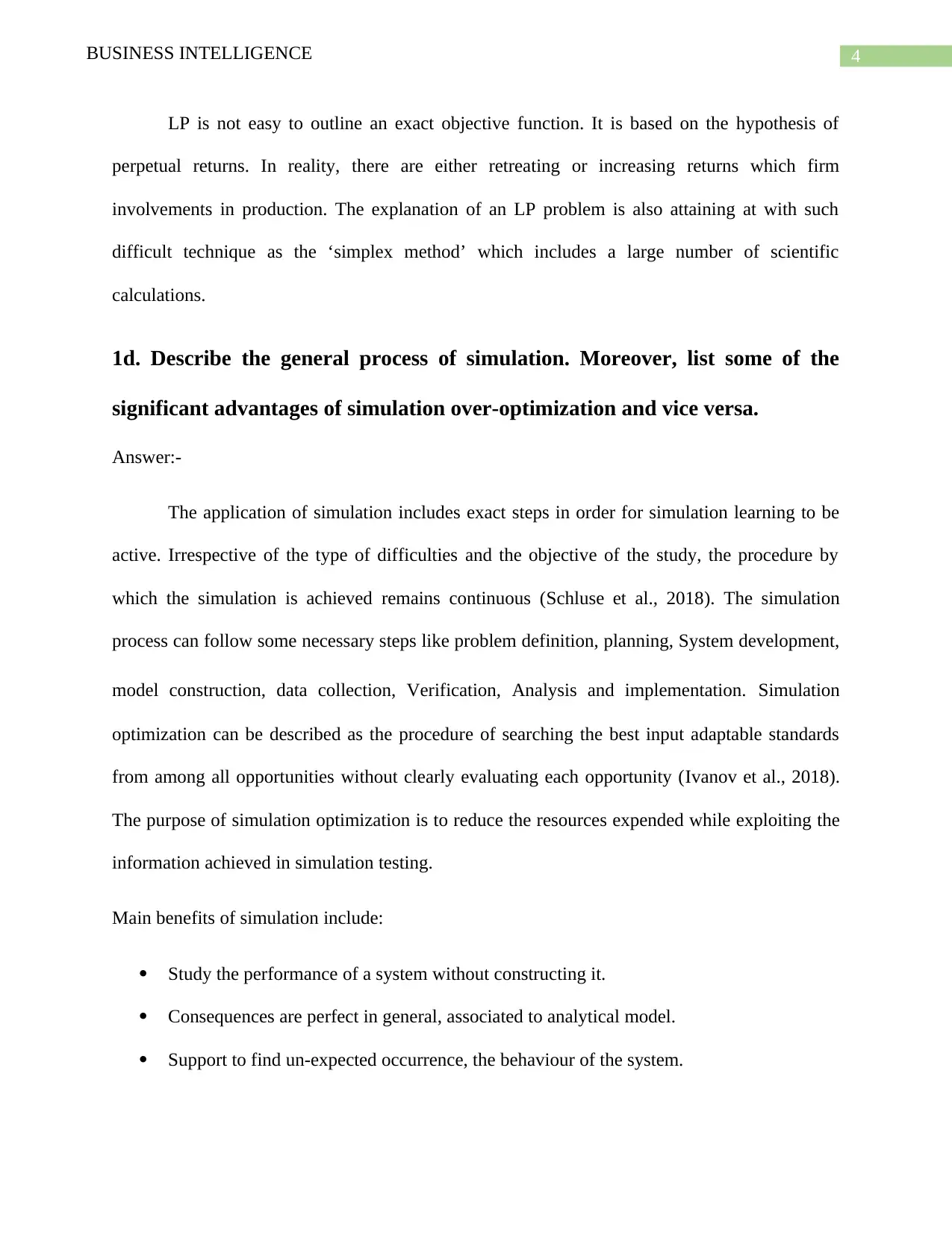
4BUSINESS INTELLIGENCE
LP is not easy to outline an exact objective function. It is based on the hypothesis of
perpetual returns. In reality, there are either retreating or increasing returns which firm
involvements in production. The explanation of an LP problem is also attaining at with such
difficult technique as the ‘simplex method’ which includes a large number of scientific
calculations.
1d. Describe the general process of simulation. Moreover, list some of the
significant advantages of simulation over-optimization and vice versa.
Answer:-
The application of simulation includes exact steps in order for simulation learning to be
active. Irrespective of the type of difficulties and the objective of the study, the procedure by
which the simulation is achieved remains continuous (Schluse et al., 2018). The simulation
process can follow some necessary steps like problem definition, planning, System development,
model construction, data collection, Verification, Analysis and implementation. Simulation
optimization can be described as the procedure of searching the best input adaptable standards
from among all opportunities without clearly evaluating each opportunity (Ivanov et al., 2018).
The purpose of simulation optimization is to reduce the resources expended while exploiting the
information achieved in simulation testing.
Main benefits of simulation include:
Study the performance of a system without constructing it.
Consequences are perfect in general, associated to analytical model.
Support to find un-expected occurrence, the behaviour of the system.
LP is not easy to outline an exact objective function. It is based on the hypothesis of
perpetual returns. In reality, there are either retreating or increasing returns which firm
involvements in production. The explanation of an LP problem is also attaining at with such
difficult technique as the ‘simplex method’ which includes a large number of scientific
calculations.
1d. Describe the general process of simulation. Moreover, list some of the
significant advantages of simulation over-optimization and vice versa.
Answer:-
The application of simulation includes exact steps in order for simulation learning to be
active. Irrespective of the type of difficulties and the objective of the study, the procedure by
which the simulation is achieved remains continuous (Schluse et al., 2018). The simulation
process can follow some necessary steps like problem definition, planning, System development,
model construction, data collection, Verification, Analysis and implementation. Simulation
optimization can be described as the procedure of searching the best input adaptable standards
from among all opportunities without clearly evaluating each opportunity (Ivanov et al., 2018).
The purpose of simulation optimization is to reduce the resources expended while exploiting the
information achieved in simulation testing.
Main benefits of simulation include:
Study the performance of a system without constructing it.
Consequences are perfect in general, associated to analytical model.
Support to find un-expected occurrence, the behaviour of the system.
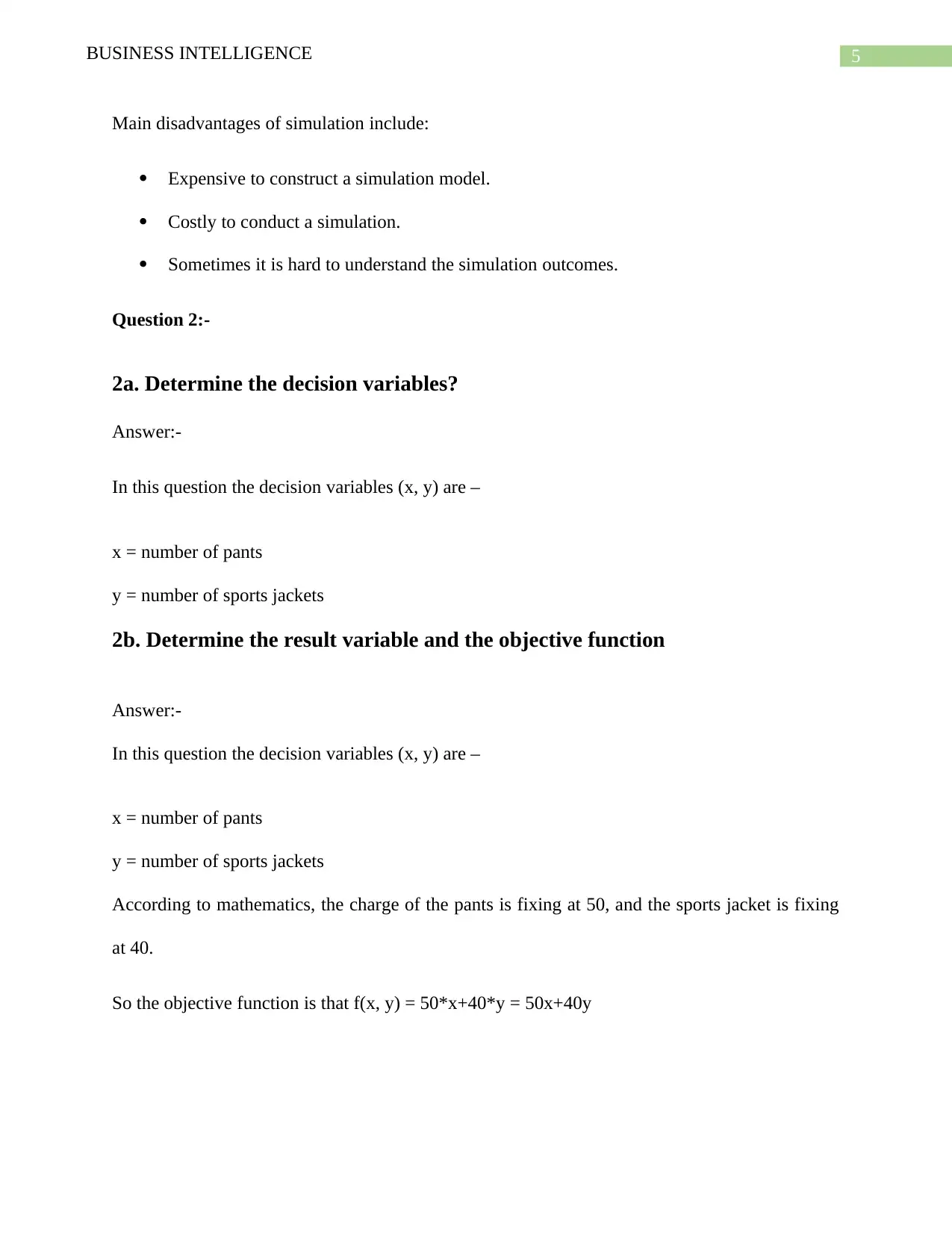
5BUSINESS INTELLIGENCE
Main disadvantages of simulation include:
Expensive to construct a simulation model.
Costly to conduct a simulation.
Sometimes it is hard to understand the simulation outcomes.
Question 2:-
2a. Determine the decision variables?
Answer:-
In this question the decision variables (x, y) are –
x = number of pants
y = number of sports jackets
2b. Determine the result variable and the objective function
Answer:-
In this question the decision variables (x, y) are –
x = number of pants
y = number of sports jackets
According to mathematics, the charge of the pants is fixing at 50, and the sports jacket is fixing
at 40.
So the objective function is that f(x, y) = 50*x+40*y = 50x+40y
Main disadvantages of simulation include:
Expensive to construct a simulation model.
Costly to conduct a simulation.
Sometimes it is hard to understand the simulation outcomes.
Question 2:-
2a. Determine the decision variables?
Answer:-
In this question the decision variables (x, y) are –
x = number of pants
y = number of sports jackets
2b. Determine the result variable and the objective function
Answer:-
In this question the decision variables (x, y) are –
x = number of pants
y = number of sports jackets
According to mathematics, the charge of the pants is fixing at 50, and the sports jacket is fixing
at 40.
So the objective function is that f(x, y) = 50*x+40*y = 50x+40y
⊘ This is a preview!⊘
Do you want full access?
Subscribe today to unlock all pages.

Trusted by 1+ million students worldwide
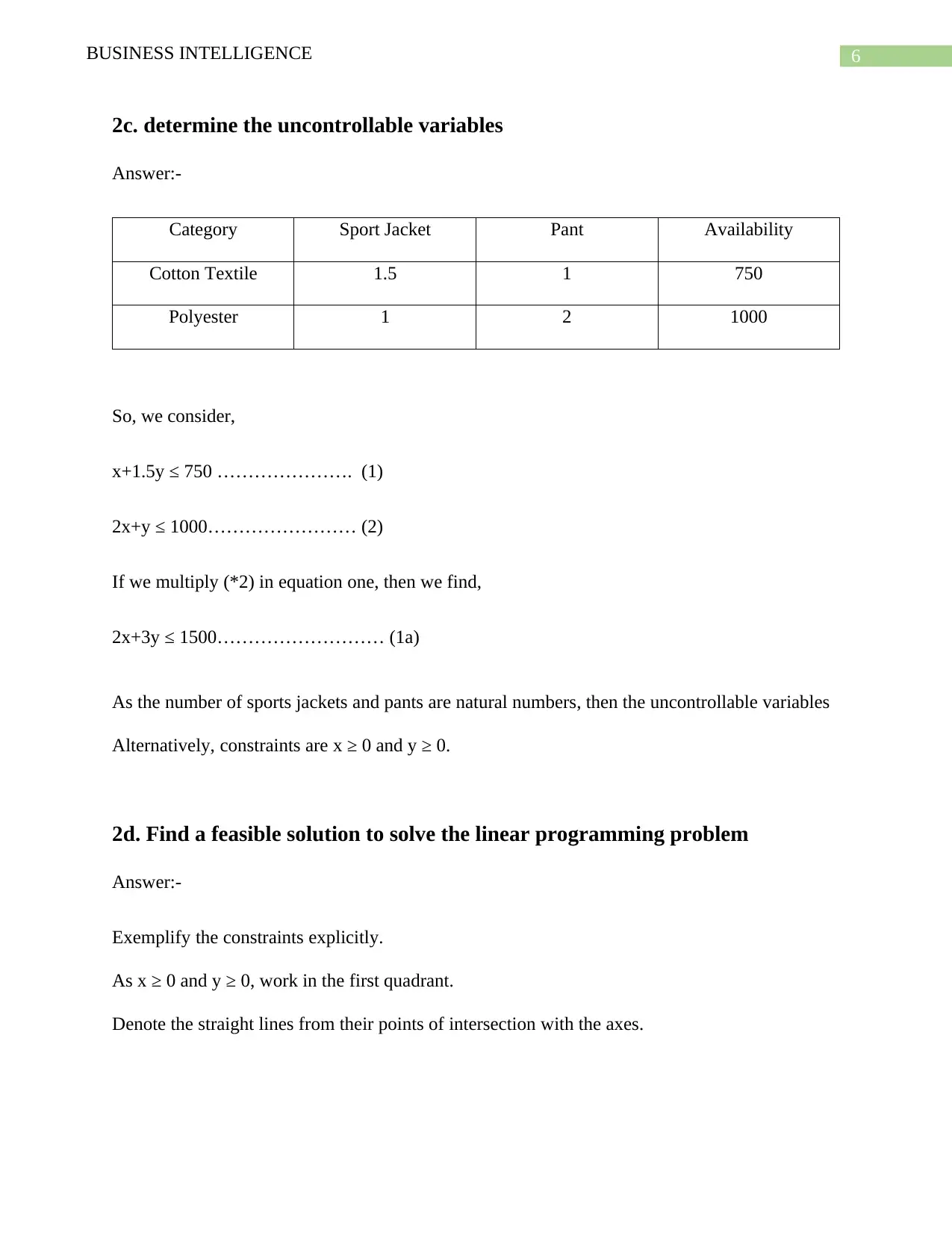
6BUSINESS INTELLIGENCE
2c. determine the uncontrollable variables
Answer:-
Category Sport Jacket Pant Availability
Cotton Textile 1.5 1 750
Polyester 1 2 1000
So, we consider,
x+1.5y ≤ 750 …………………. (1)
2x+y ≤ 1000…………………… (2)
If we multiply (*2) in equation one, then we find,
2x+3y ≤ 1500……………………… (1a)
As the number of sports jackets and pants are natural numbers, then the uncontrollable variables
Alternatively, constraints are x ≥ 0 and y ≥ 0.
2d. Find a feasible solution to solve the linear programming problem
Answer:-
Exemplify the constraints explicitly.
As x ≥ 0 and y ≥ 0, work in the first quadrant.
Denote the straight lines from their points of intersection with the axes.
2c. determine the uncontrollable variables
Answer:-
Category Sport Jacket Pant Availability
Cotton Textile 1.5 1 750
Polyester 1 2 1000
So, we consider,
x+1.5y ≤ 750 …………………. (1)
2x+y ≤ 1000…………………… (2)
If we multiply (*2) in equation one, then we find,
2x+3y ≤ 1500……………………… (1a)
As the number of sports jackets and pants are natural numbers, then the uncontrollable variables
Alternatively, constraints are x ≥ 0 and y ≥ 0.
2d. Find a feasible solution to solve the linear programming problem
Answer:-
Exemplify the constraints explicitly.
As x ≥ 0 and y ≥ 0, work in the first quadrant.
Denote the straight lines from their points of intersection with the axes.
Paraphrase This Document
Need a fresh take? Get an instant paraphrase of this document with our AI Paraphraser
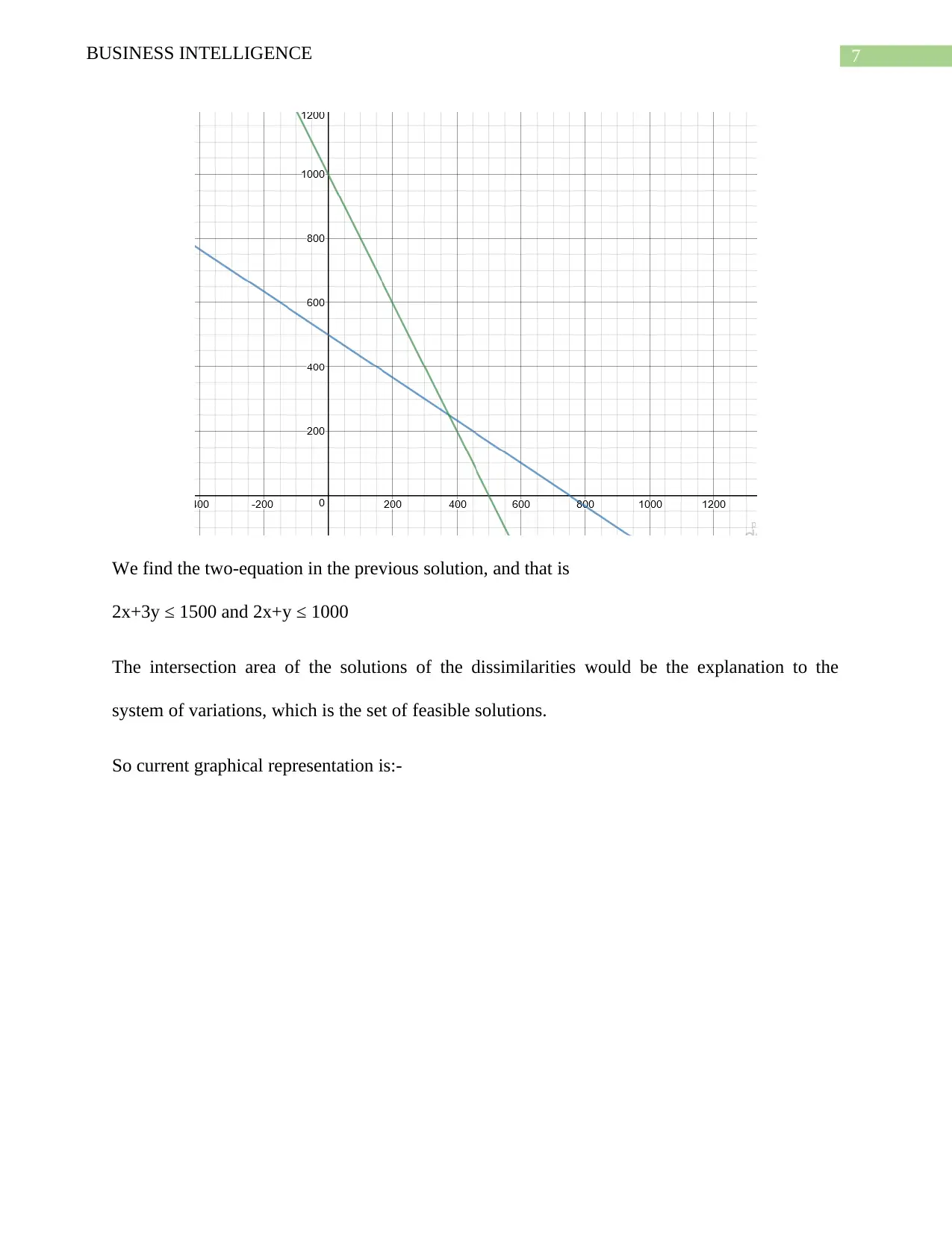
7BUSINESS INTELLIGENCE
We find the two-equation in the previous solution, and that is
2x+3y ≤ 1500 and 2x+y ≤ 1000
The intersection area of the solutions of the dissimilarities would be the explanation to the
system of variations, which is the set of feasible solutions.
So current graphical representation is:-
We find the two-equation in the previous solution, and that is
2x+3y ≤ 1500 and 2x+y ≤ 1000
The intersection area of the solutions of the dissimilarities would be the explanation to the
system of variations, which is the set of feasible solutions.
So current graphical representation is:-
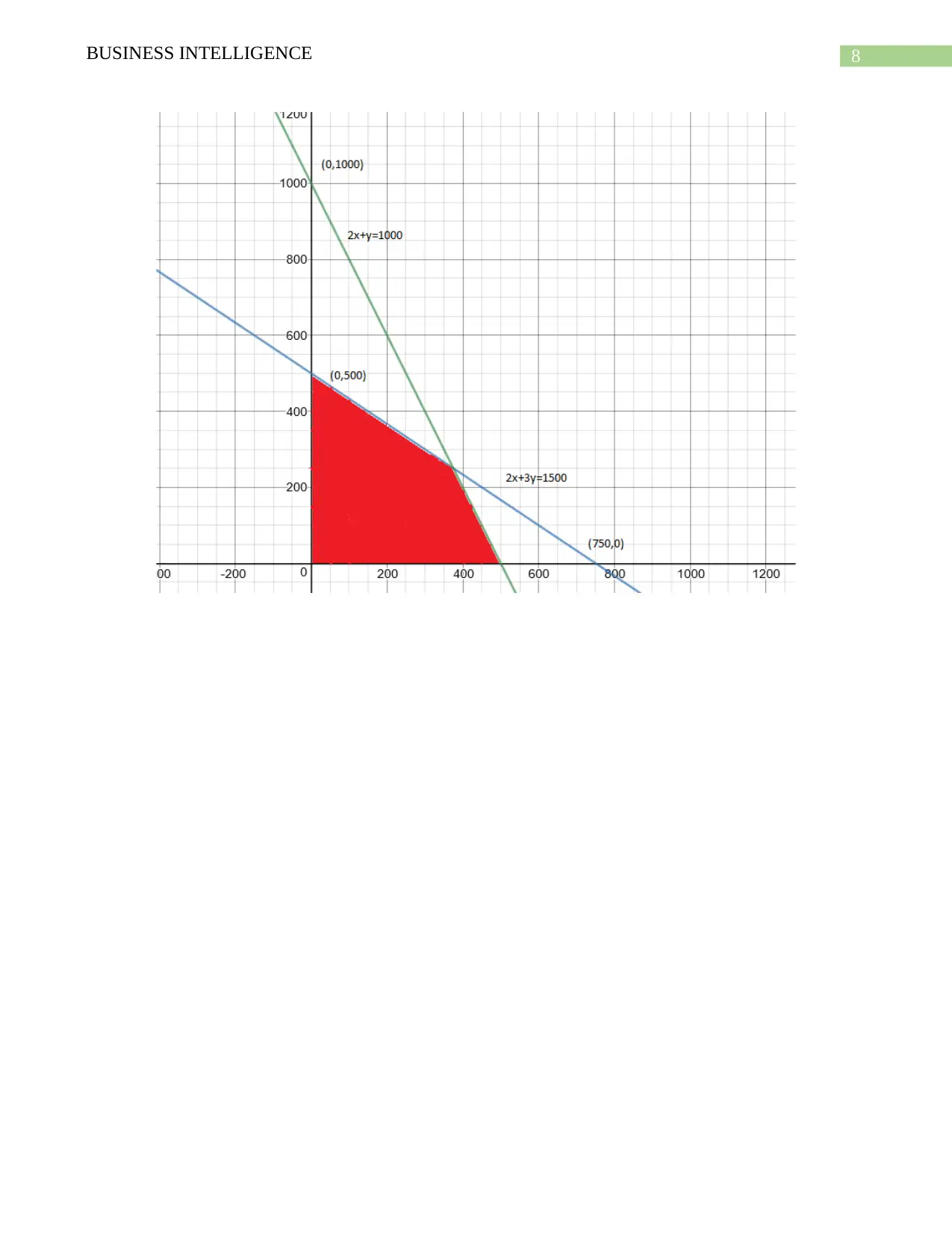
8BUSINESS INTELLIGENCE
⊘ This is a preview!⊘
Do you want full access?
Subscribe today to unlock all pages.

Trusted by 1+ million students worldwide
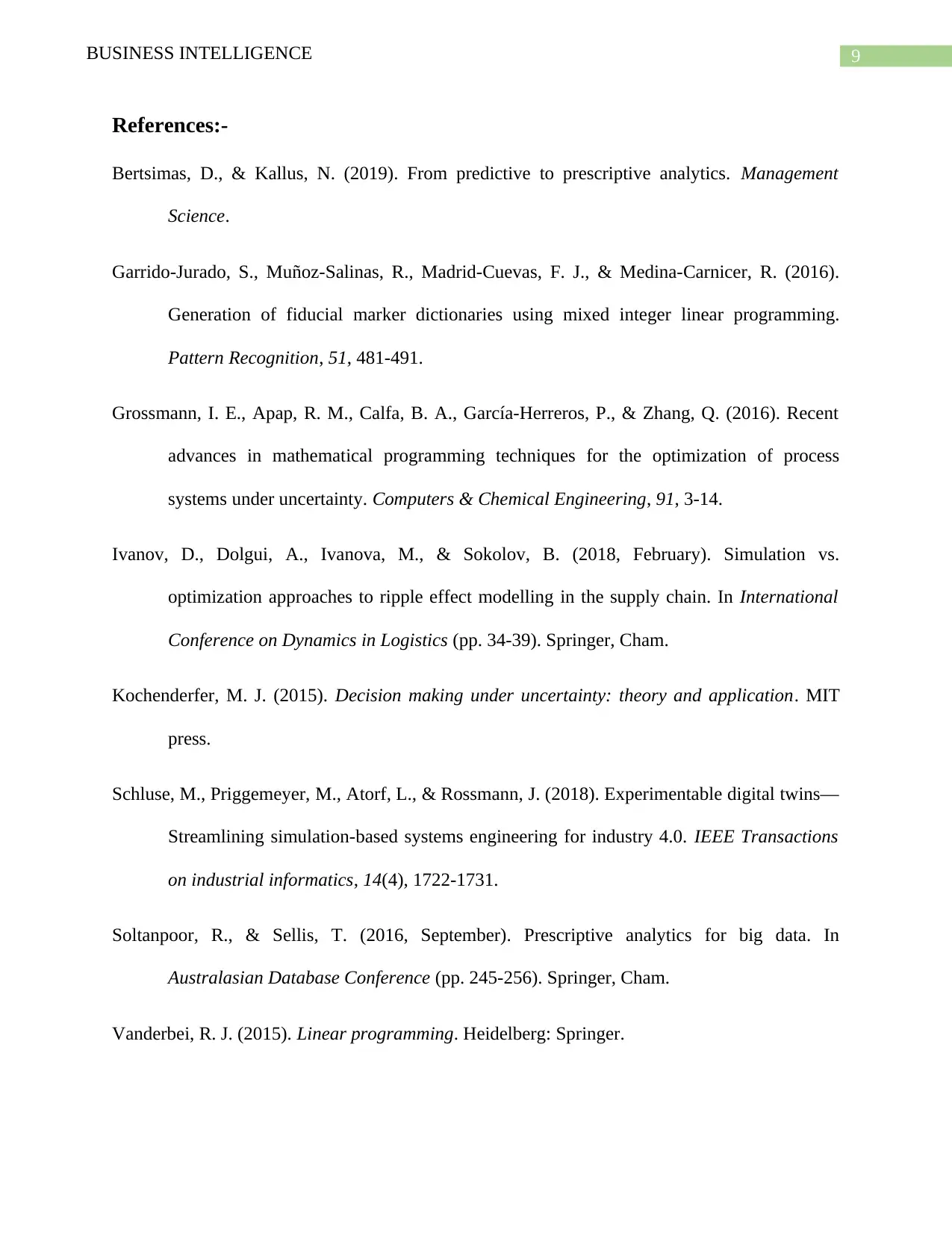
9BUSINESS INTELLIGENCE
References:-
Bertsimas, D., & Kallus, N. (2019). From predictive to prescriptive analytics. Management
Science.
Garrido-Jurado, S., Muñoz-Salinas, R., Madrid-Cuevas, F. J., & Medina-Carnicer, R. (2016).
Generation of fiducial marker dictionaries using mixed integer linear programming.
Pattern Recognition, 51, 481-491.
Grossmann, I. E., Apap, R. M., Calfa, B. A., García-Herreros, P., & Zhang, Q. (2016). Recent
advances in mathematical programming techniques for the optimization of process
systems under uncertainty. Computers & Chemical Engineering, 91, 3-14.
Ivanov, D., Dolgui, A., Ivanova, M., & Sokolov, B. (2018, February). Simulation vs.
optimization approaches to ripple effect modelling in the supply chain. In International
Conference on Dynamics in Logistics (pp. 34-39). Springer, Cham.
Kochenderfer, M. J. (2015). Decision making under uncertainty: theory and application. MIT
press.
Schluse, M., Priggemeyer, M., Atorf, L., & Rossmann, J. (2018). Experimentable digital twins—
Streamlining simulation-based systems engineering for industry 4.0. IEEE Transactions
on industrial informatics, 14(4), 1722-1731.
Soltanpoor, R., & Sellis, T. (2016, September). Prescriptive analytics for big data. In
Australasian Database Conference (pp. 245-256). Springer, Cham.
Vanderbei, R. J. (2015). Linear programming. Heidelberg: Springer.
References:-
Bertsimas, D., & Kallus, N. (2019). From predictive to prescriptive analytics. Management
Science.
Garrido-Jurado, S., Muñoz-Salinas, R., Madrid-Cuevas, F. J., & Medina-Carnicer, R. (2016).
Generation of fiducial marker dictionaries using mixed integer linear programming.
Pattern Recognition, 51, 481-491.
Grossmann, I. E., Apap, R. M., Calfa, B. A., García-Herreros, P., & Zhang, Q. (2016). Recent
advances in mathematical programming techniques for the optimization of process
systems under uncertainty. Computers & Chemical Engineering, 91, 3-14.
Ivanov, D., Dolgui, A., Ivanova, M., & Sokolov, B. (2018, February). Simulation vs.
optimization approaches to ripple effect modelling in the supply chain. In International
Conference on Dynamics in Logistics (pp. 34-39). Springer, Cham.
Kochenderfer, M. J. (2015). Decision making under uncertainty: theory and application. MIT
press.
Schluse, M., Priggemeyer, M., Atorf, L., & Rossmann, J. (2018). Experimentable digital twins—
Streamlining simulation-based systems engineering for industry 4.0. IEEE Transactions
on industrial informatics, 14(4), 1722-1731.
Soltanpoor, R., & Sellis, T. (2016, September). Prescriptive analytics for big data. In
Australasian Database Conference (pp. 245-256). Springer, Cham.
Vanderbei, R. J. (2015). Linear programming. Heidelberg: Springer.
1 out of 10
Related Documents
Your All-in-One AI-Powered Toolkit for Academic Success.
+13062052269
info@desklib.com
Available 24*7 on WhatsApp / Email
![[object Object]](/_next/static/media/star-bottom.7253800d.svg)
Unlock your academic potential
Copyright © 2020–2025 A2Z Services. All Rights Reserved. Developed and managed by ZUCOL.





